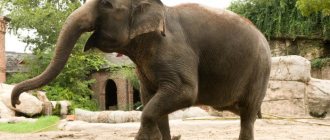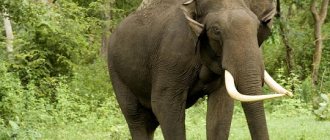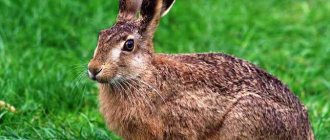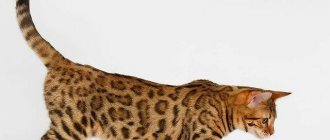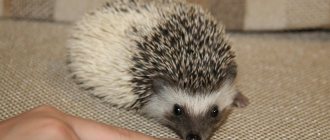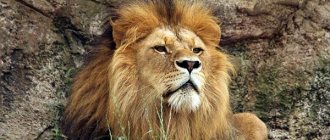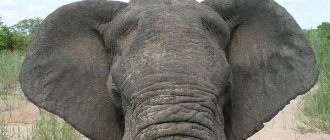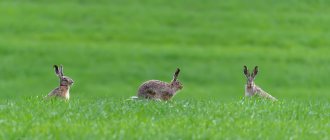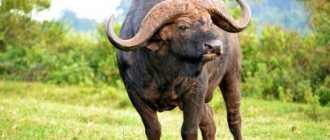- Wild animals
- >>
- Mammals
The warthog is a common species in Africa. These pigs are distinguished by their unsightly appearance, for which they got their name. They are peaceful loners and play an important role in the African ecosystem. Warthogs are hunted by many predators, and they themselves maintain a normal population of weeds and harmful insects.
Description
The weight of the African warthog ranges from 50 to 150 kg, females are 15-20 percent lighter than males. The length of the body, including the head, is 90-150 cm. The height at the withers ranges from 63.5 to 85 cm. Both sexes of the warthog have large upper fangs, the length of which is: in males 25.5-63.5 cm; females are 15.2-25.5 cm. As their name suggests, African warthogs have three pairs of warts on their faces, made of connective tissue (cartilaginous). The three types of warts include: 1) suborbital warts, growing up to 15 cm in males; 2) infraorbital warts – do not develop in most females; 3) submandibular warts - have white bristles.
The head is large with a mane growing down along the spine to the middle of the back. The body is covered with sparse setae. The color is usually black or brown. The tail is long and ends in a tuft of hair. Their low blubber content and sparse fur make African warthogs susceptible to extreme environmental temperatures.
What does a warthog eat?
Photo: Warthog pig
Warthogs are omnivores, although they prefer plant foods. Most often their diet includes:
- the roots that they get by digging up the ground with their snout;
- berries, fruits fallen from trees;
- green grass;
- nuts, young shoots;
- mushrooms (including poisonous ones - warthogs digest almost any food);
- if they come across carrion on the way, the warthogs will eat it too;
- sometimes during the feeding process they may accidentally eat small rodents or birds that are often near these pigs.
Interesting fact: Pigs have an excellent sense of smell - they are used to find valuable mushrooms - truffles.
The warthog feeds as follows. Its huge head with a short neck does not allow it to bend towards the ground, as many herbivores do, so the warthog bends its front legs at the knees, rests them on the ground and feeds in this way. In the same position, he moves, tearing the ground with his nose in search of food. In this form, it is very vulnerable to predators. Because of this lifestyle, warthogs develop calluses on their knees.
Habitat
The African warthog inhabits open and wooded savanna areas, grassy steppes, and semi-deserts in sub-Saharan Africa. Warthogs prefer open areas and avoid tropical forests and deserts. They live on Kilimanjaro up to 3000 meters above sea level and along the coastal regions of Africa. The African warthog also occupies previously wooded areas that have been cleared for pasture.
The warthog's distribution is limited due to human disturbance. Warthogs need cool places to cope with high temperatures during the day and shelters to stay warm during the cold at night.
Where does the warthog live?
Photo: Warthog in Africa
Warthogs can be found throughout Africa all the way to the Sahara Desert. They are an important part of the African ecosystem, as they are preyed upon by many predators, and warthogs themselves control the population of many harmful insects and weeds.
Unlike other representatives of the ungulate family, they lead a sedentary lifestyle and rarely move from place to place. Pigs, especially females, dig deep holes in the ground where they hide from the heat or hide from predators. Such burrows can be found in tall grass or in tree roots. Most burrowing occurs during the breeding season, when young warthogs appear. At first, they hide in shelters until they finally get stronger.
Interesting fact: Small warthogs huddle in the depths of a hole, and their mothers, walking backwards, seem to close this hole with themselves, thus protecting the offspring from predators.
These wild boars prefer to settle in areas not covered with dense forest, since it is easier for predators to hide in the forest. At the same time, wild boars often dig holes under the roots of trees and love to feast on fallen fruits, so in the savannas and copses where these wild boars live, space and vegetation are harmoniously combined.
Nutrition
The African warthog is a herbivore, but can also eat roots, berries, the bark of young trees, and in rare cases even carrion. They prefer to graze on short grasses. Warthogs use their snouts and tusks to forage for rhizomes and plant bulbs. The rhizomes of the plant bulbs serve as a source of moisture during the dry season. The African warthog also eats the droppings of rhinoceros, African buffalo, waterbuck and goat.
Scientific classification
- Kingdom: Animalia (animals)
- Phylum: Chordata
- Class: Mammalia (mammals)
- Order: Cetartiodactyla (cetodactyls)
- Family: Suidae (porcine)
- Genus and species: Phacochoerus africanus (warthog)
Other names: common, African or Abyssinian warthog.
Behavior
African warthogs live in social groups. These groups typically consist of females and their young, and can include up to 18 individuals. Males usually disperse after 2 years and lead a solitary lifestyle or create bachelor groups. African warthogs are primarily diurnal animals and prefer to hide in burrows at night. They use anteater holes or abandoned termite dwellings to sleep. To cope with high temperatures, warthogs roll in mud or water, and at low temperatures they take refuge in burrows, huddling together.
African warthogs do not exhibit territorial behavior. Different groups of warthogs have a large overlap in ranges. They may have common places for resting, feeding and watering. Warthogs are capable of changing their habitats in response to seasonal water shortages. The area range of the African warthog varies from 0.62 sq. km to 2 3.3 sq. km. km.
Natural enemies of the warthog
Photo: African warthog
All African predators feed on warthogs. Most often this is:
- groups of lionesses or young lions. They prefer to select young or weakened individuals, avoiding groups of strong, healthy warthogs;
- cheetahs also prefer small piglets;
- leopards are the most terrible enemies of warthogs, since they deftly climb trees and are perfectly camouflaged in the grass;
- hyenas can even attack a group of warthogs;
- crocodiles lie in wait for them at a watering hole;
- eagles and vultures drag away newborn cubs;
- Hippos and rhinoceroses are also dangerous, as they can attack pigs if there are cubs near these herbivores.
If a warthog sees danger, but there are cubs nearby that are worth protecting, it may rush to attack the rhino or elephant. Even small piglets can react aggressively to predators: there have been cases when a piglet attacked young lions in response, which put the predators into a state of shock, and they retreated.
Warthogs' hearing and sense of smell are acute, but their vision is weak. Therefore, they prefer to lead a daytime lifestyle, when they can not only hear the enemy, but also see him. While feeding, a warthog may encounter a black mamba, causing it to die from a bite. The greatest danger to warthogs is from people who hunt them for meat and for sport.
Reproduction
The African warthog follows a polygynous mating system. Both the male and female have many partners. Males generally do not defend their territory, but during mating periods, ritual fights between males are not uncommon. Wrestling involves pushing and using the upper blunt teeth to damage the opponent. The more dangerous lower canines are rarely used, so there are virtually no serious injuries or casualties. Adult males are usually solitary and join groups of females only for mating. Females attract wild boars with their hunched appearance and the smell of urination.
The mating periods of African warthogs depend on the seasons. As a rule, females come into heat 4-5 months after the end of the rainy season, and childbirth is expected during the dry season. Warthogs become sexually mature at 18 to 20 months of age, although males usually do not mate until they are 4 years old. African warthogs have the longest gestation period of any member of the pig family, ranging from 170 to 175 days. Litters range from 1 to 7 piglets, with an average of 3 piglets per litter. Piglets are weaned from their mother's milk around 21 weeks of age.
Female African warthogs spend most of their lives in groups, but they prefer to be alone before giving birth. Females give birth in a burrow, which plays an important role in regulating the piglets' body temperature, so newborn warthogs cannot regulate their body temperature in the first days of life. The piglets spend about 6-7 weeks in the burrow before emerging with their mother. Male warthogs stay with their mother until they are 2 years old. Females leave their mother when they reach sexual maturity, but may return to the group in the future.
Lifestyle
Behavior
Warthogs are diurnal . They spend most of the day grazing or lying on the ground. At night they will seek shelter in the burrows of aardvarks and porcupines, falling asleep with their heads towards the opening of the burrow; this should allow them to quickly escape from the hole.
Photo: Wolfgang Hasselmann
When the animals graze, they tuck their forelimbs to lower their heads to the tips of the short grass, resting on their calloused “knees.” Warthogs take the same pose when drinking water from reservoirs. In contrast, when uprooting plants during the dry season, they use their hardened, fanged snout to rake the soil in search of bulbs, tubers and roots.
These animals lead a sedentary lifestyle . The lack of seasonal migration distinguishes them from other ungulates.
Warthogs are highly vocal and produce a wide range of grunts, growls, snorts and squeals that serve as greetings, maintenance of contact, warning calls and displays of threat.
Social structure
Common warthogs live in one of three social units:
- single adult males;
- bachelor groups of young males;
- family groups of 4 to 16 individuals, usually related females and their mixed-sex offspring.
Photo: Jean-Daniel Calame
Males prefer a bachelor lifestyle, joining females only for mating. But females, before giving birth to a new litter, sometimes drive away the litter they raised earlier. Abandoned juveniles may briefly join another lone female or form bachelor groups before striking out on their own. In this case, males remain within the home range, while females are usually accepted back into their natal groups with other females and young offspring.
Lifespan
Researchers in eastern Selous, Tanzania have determined that the average lifespan of a warthog is 7-11 years. Other sources indicate that the African warthog can live up to 18 years.
Warthog piglets are very vulnerable to extreme low and high temperatures, as well as to predators, which is responsible for less than 50% survival of the young in their first year of life. Other common causes of mortality in adult warthogs are predation, human disturbance, hunting, and disease.
Varieties
There are four recognized subspecies of warthogs:
- Nolan warthog (Phacochoerus africanus africanus) found in Ivory Coast, Burkina Faso, Democratic Republic of Congo, Chad, Ethiopia, Ghana, Guinea-Bissau, Mauritania, Sudan, Nigeria and Senegal;
- Eritrean warthog (Phacochoerus africanus aeliani) found in Ethiopia, Eritrea, Djibouti and Somalia;
- the Central African warthog (Phacochoerus africanus massaicus) is found in Kenya and Tanzania;
- The southern warthog (Phacochoerus africanus sundevallii) lives in Namibia, South Africa, Botswana and Zimbabwe.
Communication and perception
African warthogs have poor eyesight, but their hearing and sense of smell are keen. In case of danger, the warthog raises its tail in a vertical position as a signal to individuals of its species. During friendly meetings, they rub their infraorbital glands against each other. Female African warthogs use frequent urination to demonstrate to males that they are ready to mate. During fights, the loser usually squeals and runs away, while the winner leaves him alone. When fighting and mating, warthogs growl and grind their teeth.
Is a wild boar dangerous for humans?
Yes, quite dangerous. But only if you are a hunter and are trying to shoot him or if there is a threat to his cubs. So, the wild boar is a peace-loving animal and will never be the first to attack a person. But a wounded boar is a completely different matter; from a good-natured bumpkin, he instantly turns into a real monster with burning eyes. An angry, wounded boar charging at a person is quite capable of terrifying even experienced hunters. And sometimes such a hunt can end very badly for the hunters themselves; there are cases when people died from the fangs of such an angry boar while hunting.
Therefore, we urge you, if you are planning to hunt a wild boar, then let it be exclusively a photo hunt.
Predators
The main threat to warthogs comes from lions. They avoid nocturnal predators by being active during the day and hiding in burrows at night. They have special signals that warn other individuals of the approach of predators. African warthogs can change their activity patterns to avoid encounters with people. In areas of human contact, warthogs often become more active at night.
Save Status
Populations of common warthogs are relatively large and stable, which is why they are classified as "Least Concern" . Although warthogs are not endangered, these animals are often hunted by poachers for their meat, hides and tusks.
The main threats in East Africa are human-induced degradation, habitat loss and fragmentation, and competition with livestock for water and food. This species is regularly persecuted for raiding fields of wheat, rice, beans or peanuts. In some agricultural areas, warthogs have been eradicated because they can potentially carry African swine fever.
To protect warthogs, protected spaces and wildlife corridors are created - large areas of land that wildlife can use to move from one park or state to another. Corridors connect protected areas and allow warthogs to move safely between them.
Interesting Facts
- The size of a wild pig's warts increases with age, making its appearance even more menacing and terrifying. In an elderly male, the length of skin growths can reach 15 centimeters.
- The tip of the tail is slightly thickened. When there is danger, the animal lifts it up, after which the tail becomes like a radio antenna. For this funny feature, the animal received the playful nickname “Radio Africa”.
- When sorting out relationships, males never use fangs against each other. They behave like rams - they collide with their foreheads and try to move their opponent from their place.
Pig diseases
To understand everything about pigs, you must learn about the pathologies that are inherent in them. Diseases can be infectious or non-infectious. Most often they occur when maintenance rules are violated, when food is stored in poor conditions and served stale. Dangerous bacteria and viruses can accidentally enter farms along with feed, equipment, and cars traveling from infected regions. Often, ringed and flatworms, their eggs and larvae enter the intestines with food.
In order to identify pathologies in time, you need to know their main symptoms. In most cases, sick animals become lethargic, depressed, eat poorly, fall on their sides and sometimes a pig squeals loudly for no reason. (It is no coincidence that the expression “squeal like a pig” appeared). Pigs may develop a fever, a rash, or purple or blue spots on their skin. The pig's stubble becomes ruffled, becomes dull, and snot and pus flow from the eyes and nose. If a pig is poisoned or has an intestinal infection, diarrhea and vomiting occur, which lead to dehydration. A mild disease can go away on its own; in severe cases, the mortality rate often reaches 100%.
The most common diseases of pigs are:
- ascariasis;
- cystocercosis;
- macracanthorhynchosis;
- leptospirosis;
- salmonellosis;
- erysipelas or erysipelas;
- rotavirus infection;
- circovirus;
- brucellosis;
- swelling;
- mastitis in sows;
- dysentery;
- flu;
- atrophic rhinitis;
- pasteurellosis;
- pleurisy;
- arthritis;
- anemia;
- vitamin deficiency or hypovitaminosis;
- foot and mouth disease;
- anthrax;
- food poisoning;
- lichen;
- scabies;
- scab;
- ear mite;
- ixodid ticks;
- classical and African plague.
Treatment of diseases depends on what diagnosis is made. The drug and its dose should be selected by a veterinarian; only he can correctly understand the signs and symptoms of pathologies. To treat bacterial infections, antibiotics are used, for example, gentamicin, metronidazole, injections of nitox, bicillin. In case of parasitic infestations, in order to deworm pigs, they give antihelminthic drugs: albendazole or alben, brovermectin. For vitamin deficiency, tetravit and other vitamin supplements are given, for anemia - iron.
Viral diseases are often incurable, the prognosis for them is poor, and the entire herd is killed when infected. For prevention, vaccination is used and sanitary and hygienic measures are carried out. You should consult your veterinarian about all vaccinations and prevention of dangerous infections.
